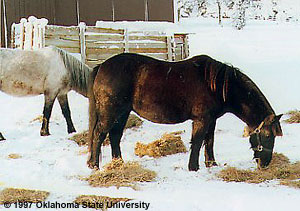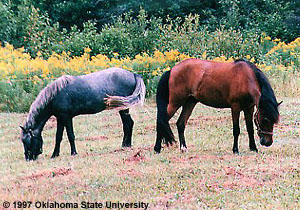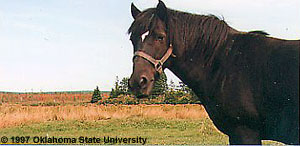Newfoundland Pony
 The Newfoundland Pony has long been a proud part of Newfoundland culture and history.
The Newfoundland Pony has long been a proud part of Newfoundland culture and history.
Early settlers brought from the British Isles Exmoor, Dartmoor, New Forest, Galloway, Welsh, Connemara and the odd Highlands ponies. These ponies, for nearly three centuries, interbred until one common pony developed "The Newfoundland Pony."
The pony that emerged was perfectly suited for the rough Newfoundland environment.
Characteristics
- Approximately 11 to 14.2 hands high.
- It has a thick dark mane, tail and lower legs. It is commonly brownish in color though other
 colors are not uncommon.
colors are not uncommon.- Some experience mild to radical color changes from one season to the next.
- It can weigh around 400 up to 800 lbs.
- It often has a small head with deep jowls.
- Short hairy ears.
- Small flint hard hoofs.
- Low set tail.
Perhaps greatest attributes of the Newfoundland Pony are its good temperament, and ability to survive on relatively small amounts of most available grasses and foods. Also it can stand harsh winters in relative comfort mostly due to its thick winter coat.
Our Heritage
These hardworking and loyal ponies hauled firewood, timber, kelp, rocks and many more things. They transported their owners by back, cart and wagon in times before the car. They were an integral part of the Newfoundland way of life right up to the late 1940's and 50's and in some places beyond.
The Pony's Demise
Why then are there so few Newfoundland Ponies left?
In 1935 there were 9025 ponies in Newfoundland and a healthy population existed up to the mid seventies and early eighties. Then the population plummeted!
Perhaps the greatest causes of this decline were:
- Machinery now took over the jobs once done by ponies.
- Communities enacted no roaming laws limiting breeding and a food supply.
- Owners were encouraged to have stallions gelded.
- Thousands of the Newfoundland Ponies were sold to meat processing plants in Quebec from where the horse meat was sent to Belgium and France for human consumption.
 In 1997, there were 144 known Newfoundland Ponies of which a sizeable number were
geldings and aged mares. On September 12th, 1997, the Government of Newfoundland declared
the Newfoundland Pony as a Heritage Animal for the province. Restrictions have been
made on the export and disposal of these animals, and the Newfoundland Pony Society
named as the official public group responsible for registering, promoting and protecting
this animal. In 1998, the number of registered ponies is 214 and climbing. The future
is bright for this animal with the goal being to register the Newfoundland Pony as
an official breed under Canada's Animal Pedigree Act through the efforts and coordination
of the Newfoundland Pony Society.
In 1997, there were 144 known Newfoundland Ponies of which a sizeable number were
geldings and aged mares. On September 12th, 1997, the Government of Newfoundland declared
the Newfoundland Pony as a Heritage Animal for the province. Restrictions have been
made on the export and disposal of these animals, and the Newfoundland Pony Society
named as the official public group responsible for registering, promoting and protecting
this animal. In 1998, the number of registered ponies is 214 and climbing. The future
is bright for this animal with the goal being to register the Newfoundland Pony as
an official breed under Canada's Animal Pedigree Act through the efforts and coordination
of the Newfoundland Pony Society.
The Newfoundland Pony Society in cooperation with individual owners, Joywind Rarebreeds Conservancy (Ontario), the Andrew Ferguson Fraser Equine Care Trust, and the Torbay Newfoundland Pony Project have set up protected breeding units at Pt. Leamington, Deer Lake, Manuels, Crowley's Island, Long Hr., Bay Roberts, St. Brendan's, Green's Hr. and Torbay.
These efforts are increasing the numbers and securing the future for the Newfoundland Pony.
References
The Newfoundland Pony Society, Box 5024, St. John's, NF Canada, A1C 5V3
